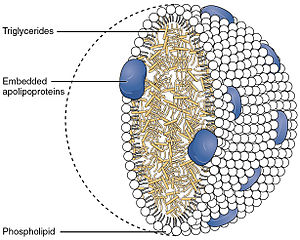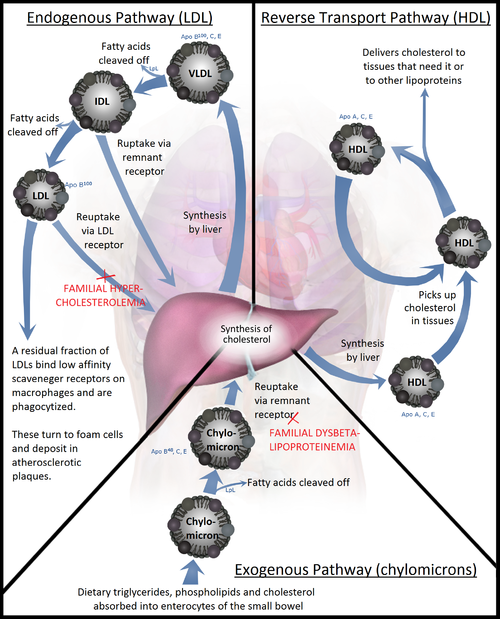Question #85ff2
1 Answer
Simple Question, Complex answer....
To get it into perspective, I'll explain the lot.
Explanation:
There are three pathways in Lipid Transport.
Let's start with the first one:
1 Exogenous Pathway.
Fat stuff from your diet ( triglycerids, phospholipids, cholesterol )
is extracted in the intestines. It has to be stored in the liver , but it can not be dumped in the bloodstream on its own, as these molecules are apolar so they won't dissolve in the polar (watery) bloodstream.
They are therefore packed in (big) vesicles called Chylomicrons , often also referred to as ULDL (Ultra Low Density Lipoprotein).
Chylomicron:

On their way to the liver they deliver their content to adipose, cardiac and skeletal muscle tissue. They finally end their life by being taken up and destroyed in the liver .
2 Endogenous Pathway.
For export, the liver packs the triglycerides and cholesterol (the latter in the form of cholesterylesters) in a new transport vesicle referred to as VLDL (Very Low Density Lipoprotein).
On its way in the bloodstream, the vesicle once again delivers its payload to the adipose and muscle tissues. This release is achieved by hydrolysis of the vesicle, eventually turning it into IDL: Intermediary Dense Lipoprotein. (also called a VLDL remnant ).
These remnants can be taken up once again by the liver, or further hydrolysed by Hepatic Lipase. If the latter happens, the resulting vesicles are known as LDL (Low Density Lipoprotein), or, alternatively, IDL remnants. They contain a relatively high level of cholesterol. The LDL-vesicles are ultimately absorbed by the liver and peripheral cells through Endocytosis, releasing (mainly) Cholesterol, as well as other lipids....
3 Reverse Transport Pathway.
Unlike the Lipoproteins mentioned so far, which transport fats and Cholesterol from the liver to the tissues, HDL (High Density Lipoprotein) carries cholesterol from the tissue to the liver. Apart from the liver, Steroidogenic organs are on the adress-list as well, since Cholesterol is the main Raw Material for Steroids such as Testosterone, Oestron, Progesteron etc.
HDL particles are sometimes referred to as "good cholesterol" because they can transport fat molecules out of artery walls, reduce macrophage accumulation, and thus help prevent or even regress atherosclerosis...
The summary given by no means gives a complete picture of the whole proccess: I haven't even mentioned apoLipoProteins!
But I hope this gives an overall picture of the Fat/Cholesterol Metabolism...

Pictures: courtesy of Wikipedia....
The reason HDL is considered "Good" is that it takes fats OUT of the artery -walls, thereby reducing the potential risk of AtheroSclerosis, and potentially Stroke, So, it is considered healthy.
LDL on the other hand, deposits the bad stuff there so is NOT good for your health...
When a "Cholesterol"-test is done, what they actually measure is the ratio of LDL to HDL present in your blood: too high a value, and this indicates an unhealthy diet: you import more fat than you should, and consequently more LDL vesicles are being made to transport the stuff to the tissues....

